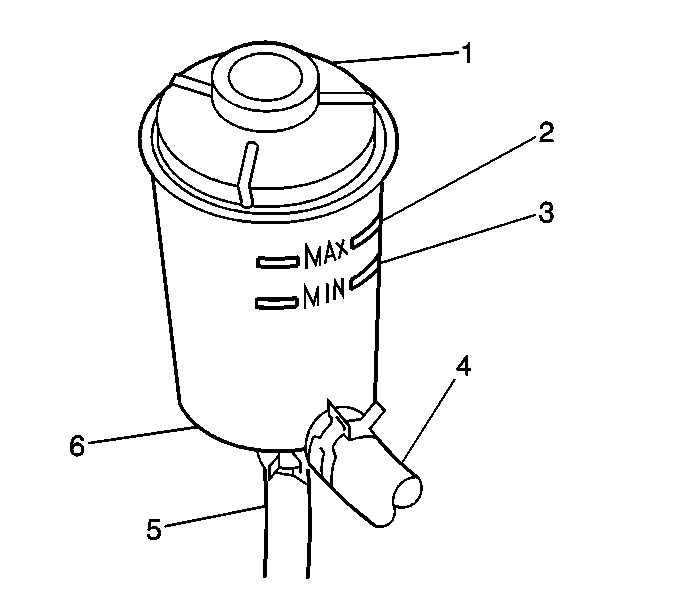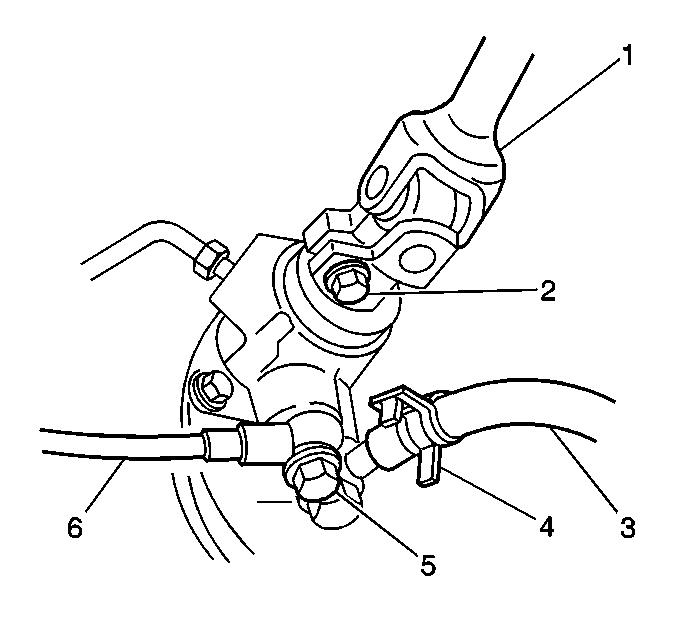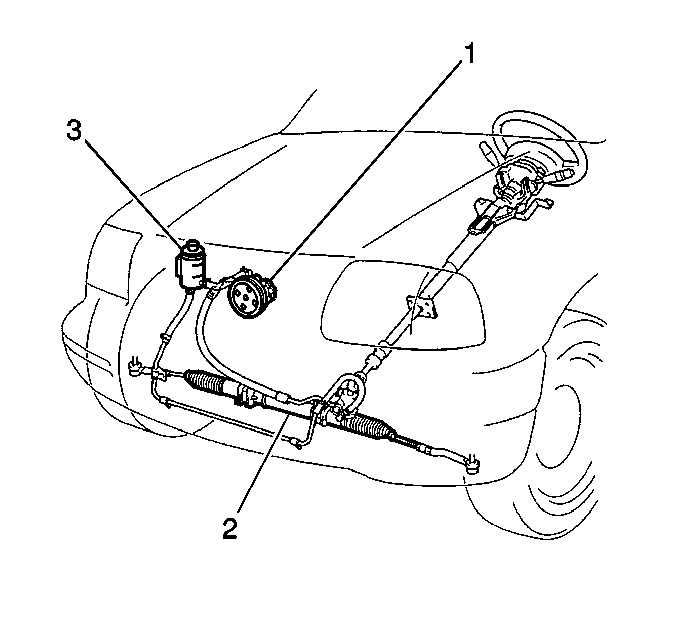Power Steering Gear Pipe/Hose Replacement - Inlet 1.6L
Power Steering Gear Inlet Pipe Removal Procedure
Important: The power steering gear inlet pipe connects the power steering gear to the power steering gear inlet hose.
- Use a siphon in order to remove the power steering fluid from the reservoir (6).
- Remove the power steering gear inlet pipe fitting (5) from the steering gear.
- Remove the power steering gear inlet pipe and the 2 gaskets from the steering gear.
- Remove the power steering gear inlet pipe from the power steering gear inlet hose.


Notice: Do not start the vehicle with any power steering gear inlet or outlet hoses disconnected. When disconnected, plug or cap all openings of components. Failure to do so could result in contamination or loss of power steering fluid and damage to the system.
Important: Place a drain pan under the vehicle in order to catch any escaping fluid.
Power Steering Gear Inlet Pipe Installation Procedure
- Install the power steering gear inlet pipe to the power steering gear inlet hose.
- Install the power steering gear inlet pipe (6) and the 2 gaskets to the steering gear. Secure the pipe to the gear with the pipe fitting (5).
- Add power steering fluid to the reservoir. Refer to Checking and Adding Power Steering Fluid .
- Bleed the power steering system. Refer to Power Steering System Bleeding .
Notice: Use the correct fastener in the correct location. Replacement fasteners must be the correct part number for that application. Fasteners requiring replacement or fasteners requiring the use of thread locking compound or sealant are identified in the service procedure. Do not use paints, lubricants, or corrosion inhibitors on fasteners or fastener joint surfaces unless specified. These coatings affect fastener torque and joint clamping force and may damage the fastener. Use the correct tightening sequence and specifications when installing fasteners in order to avoid damage to parts and systems.
Tighten
Tighten the power steering gear inlet hose to the power steering gear
inlet pipe connection to 40 N·m (29 lb ft).

Notice: The inlet and outlet hoses must not be twisted during installation. Do not bend or distort the inlet or outlet hoses to make installation easier. Failure to follow these procedures could result in component damage.
Tighten
Tighten the fitting to 35 N·m (25.5 lb ft).
Notice: When adding fluid or making a complete fluid change, always use the proper power steering fluid. Failure to use the proper fluid will cause hose and seal damage and fluid leaks.
Notice: If the power steering system has been serviced, an accurate fluid level reading cannot be obtained unless air is bled from the steering system. The air in the fluid may cause pump cavitation noise and may cause pump damage over a period of time.
Power Steering Gear Inlet Hose Removal Procedure
Important: The power steering gear inlet hose connects the power steering gear inlet pipe to the power steering pump.
- Use a siphon in order to remove the power steering fluid from the reservoir (6).
- Remove the power steering gear inlet hose fitting from the power steering pump.
- Remove the power steering gear inlet hose and the 2 gaskets from the power steering pump.
- Remove the power steering gear inlet hose from the power steering gear inlet pipe.

Notice: Do not start the vehicle with any power steering gear inlet or outlet hoses disconnected. When disconnected, plug or cap all openings of components. Failure to do so could result in contamination or loss of power steering fluid and damage to the system.
Important: Place a drain pan under the vehicle in order to catch any escaping fluid.
Power Steering Gear Inlet Hose Installation Procedure
- Install the power steering gear inlet hose to the power steering gear inlet pipe.
- Install the power steering gear inlet hose and the 2 gaskets to the power steering pump. Secure the hose to the pump with the hose fitting.
- Add power steering fluid to the reservoir (6). Refer to Checking and Adding Power Steering Fluid .
- Bleed the power steering system. Refer to Power Steering System Bleeding .
Notice: Use the correct fastener in the correct location. Replacement fasteners must be the correct part number for that application. Fasteners requiring replacement or fasteners requiring the use of thread locking compound or sealant are identified in the service procedure. Do not use paints, lubricants, or corrosion inhibitors on fasteners or fastener joint surfaces unless specified. These coatings affect fastener torque and joint clamping force and may damage the fastener. Use the correct tightening sequence and specifications when installing fasteners in order to avoid damage to parts and systems.
Notice: The inlet and outlet hoses must not be twisted during installation. Do not bend or distort the inlet or outlet hoses to make installation easier. Failure to follow these procedures could result in component damage.
Tighten
Tighten the power steering gear inlet hose to the power steering gear
inlet pipe connection to 40 N·m (29 lb ft).
Tighten
Tighten the fitting to 60 N·m (43.5 lb ft).

Notice: When adding fluid or making a complete fluid change, always use the proper power steering fluid. Failure to use the proper fluid will cause hose and seal damage and fluid leaks.
Notice: If the power steering system has been serviced, an accurate fluid level reading cannot be obtained unless air is bled from the steering system. The air in the fluid may cause pump cavitation noise and may cause pump damage over a period of time.
Power Steering Gear Pipe/Hose Replacement - Inlet 2.0L
Removal Procedure
- Use a siphon in order to remove the power steering fluid from the reservoir (6).
- Remove the power steering gear inlet hose fitting (5) from the steering gear.
- Remove the power steering gear inlet hose and the 2 gaskets from the steering gear.
- Remove the power steering gear inlet hose fitting from the power steering pump (1).
- Remove the power steering gear inlet hose and the 2 gaskets from the power steering pump.
- Remove the power steering gear inlet hose from the bracket.
- Remove the power steering gear inlet hose from the vehicle.


Notice: Do not start the vehicle with any power steering gear inlet or outlet hoses disconnected. When disconnected, plug or cap all openings of components. Failure to do so could result in contamination or loss of power steering fluid and damage to the system.
Important: Place a drain pan under the vehicle in order to catch any escaping fluid.

Installation Procedure
- Install the power steering gear inlet hose and the 2 gaskets to the power steering pump (1). Secure the hose to the pump with the fitting.
- Install the power steering gear inlet hose (6) and the 2 gaskets to the steering gear. Secure the hose to the gear with the fitting (5).
- Install the power steering gear inlet hose to the hose bracket.
- Add power steering fluid to the reservoir. Refer to Checking and Adding Power Steering Fluid .
- Bleed the power steering system. Refer to Power Steering System Bleeding .

Notice: Use the correct fastener in the correct location. Replacement fasteners must be the correct part number for that application. Fasteners requiring replacement or fasteners requiring the use of thread locking compound or sealant are identified in the service procedure. Do not use paints, lubricants, or corrosion inhibitors on fasteners or fastener joint surfaces unless specified. These coatings affect fastener torque and joint clamping force and may damage the fastener. Use the correct tightening sequence and specifications when installing fasteners in order to avoid damage to parts and systems.
Notice: The inlet and outlet hoses must not be twisted during installation. Do not bend or distort the inlet or outlet hoses to make installation easier. Failure to follow these procedures could result in component damage.
Tighten
Tighten the fitting to 60 N·m (43.5 lb ft).

Tighten
Tighten the fitting to 35 N·m (25.5 lb ft).
Notice: When adding fluid or making a complete fluid change, always use the proper power steering fluid. Failure to use the proper fluid will cause hose and seal damage and fluid leaks.
Notice: If the power steering system has been serviced, an accurate fluid level reading cannot be obtained unless air is bled from the steering system. The air in the fluid may cause pump cavitation noise and may cause pump damage over a period of time.
